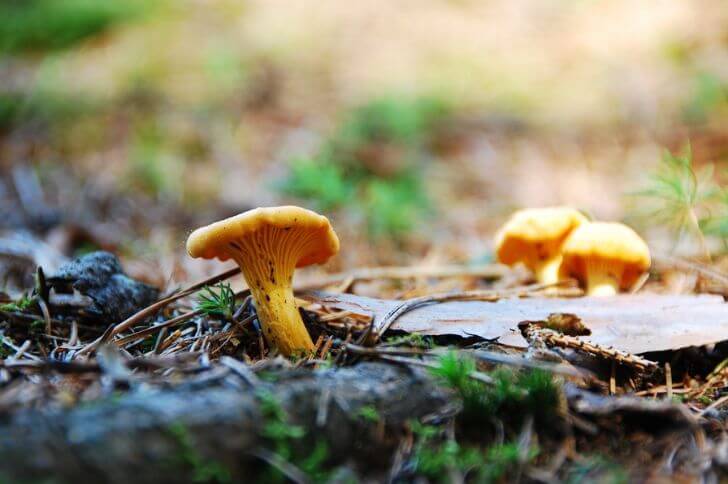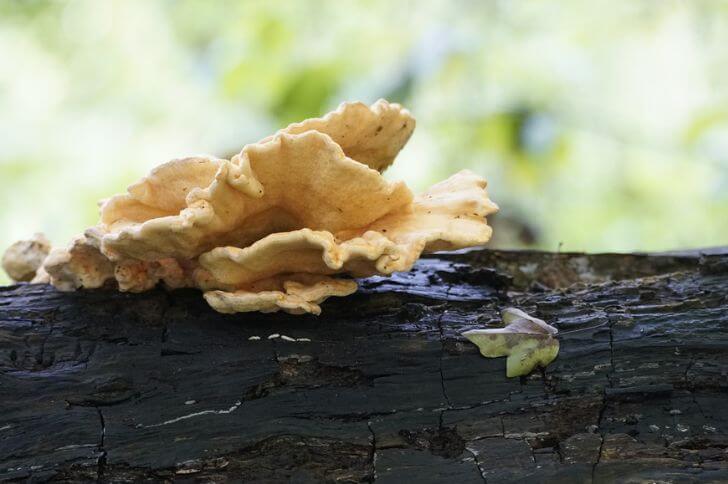Mushrooms are a fascinating part of the natural world, and the Midwest is particularly abundant in them.
From morel mushrooms to chanterelles and Hedgehog mushrooms, each region has unique fungi that can be found there.
Whether you’re a novice or experienced mushroom hunter, exploring the hidden fungal treasures of the Midwest is an exciting and rewarding experience.
Below we discuss these mushrooms, making identification easy for every forager in this region. Here are the top 10 mushrooms of the Midwest.
List of Midwest Mushrooms
1. Chanterelles

Chanterelle mushrooms are common in most Midwest states. There are four main varieties that grow in this region.
Cinnabar chanterelles – Also known as the red chanterelle, these are one of the smallest fungi of this family. They are mostly found under oaks. Caps are small, red and vase-shaped. Texture is smooth and they grow off the ground.
Cantharellus flavus – This variety is often found in Wisconsin. They are egg-yellow in color with a funnel-shaped fruiting body. Under the cap you’ll spot pseudo-gills. You can also identify them by their smell reminiscent of apricots.
Cantharellus roseocanus – With it strikingly bright orange color, the cantharellus roseocanus is a mid-size mushroom that can be found under spruces, growing individually or in loose clusters. Its color ranges from pale yellow to orangish. Also its flesh is white and does not stain when cut or bruised.
2. Crowned-Tipped Coral
Crowned-tipped coral, Artomyces pyxidatus, is a distinctive edible mushroom that is quite elusive. It is also known as crown coral.
Identification:
Because there are a few look-alikes, you need to pay close attention while foraging for this Midwest mushroom.
Unlike most coral mushrooms, crown corals grow on wood; particularly dying oaks. They are white when young turning cream to yellowish with age.
This species of coral has an arborescent and columnar growth form with its corallites, arranged in a spiral pattern along its branches. The tips of each branch are typically crowned with finger-like projections that give this species its name.
3. Elm Oyster
Elm oysters are uncommon. Thankfully, through technology you can grow them at home. But if you prefer foraging, you can identify elm oysters by;
Identification:
Their fruiting body is similar to other oyster varieties such as pearl oyster. However, the most distinguishing feature is they grow singly on elms or maples.
They have a bright white color when young that changes tan with age. The gills are white and crowded while the also white stems are smooth with no ring.
Elm oyster mushrooms provide a meaty texture when cooked, making them popular among mushroom enthusiasts in the Midwest.
Related Read: Common mushrooms of Indiana
4. Old Man Of The Woods
Not only does this Midwest mushroom have a unique name but its unique appearance makes identification easy.
Identification:
There are three ways to identify these Midwest mushrooms. One, you can forage for them from July to October growing singly around hardwoods especially oaks.
Two, the fruiting body of the old man of the woods is tall, growing to 2-5 inches tall. The body is umbrella shaped and grayish with large dark scales. Its underside is characterized with whitish gills that’ll turn black with age.
Three, when you see this Midwest fungi it looks shaggy and feels woolly. Though it has an odd name and strange look, this gray mushroom is edible. Young species have an earthy flavor.
5. Yellow-cracking Bolete
Yellow-cracking bolete mushrooms are common in Wisconsin but can also be found in the other Midwest states.
Identification:
With an average cap size ranging from 1.6-3.9 inches wide, these mushrooms stand out in the environment due to their bright coloration. They can also be distinguished by their yellowish stems with reddish stains.
The caps are brownish yellowish and almost flat when mature. Its smooth surface also cracks with age, giving them the ‘cracking’ name. Note like other boletes they have pores.
Though they do not have a distinctive taste, they make a great addition to any mushroom dish.
6. Dryad’s Saddle
Dryad Saddle mushrooms are some of the largest mushrooms of the midwest. They are hard to miss.
Identification:
Formerly called Polyporus squamosus, the dryad’s saddle or Cerioporus squamosus often grows in tiers and clusters.
These medium to large mushrooms can range anywhere from three to twenty inches in size and have oddly shaped caps due to clustering.
The tops of Dryad Saddle mushrooms are usually tan in color with dark scale-like marks, while their undersides are whitish. The stalks of these mushrooms are typically white and darken with age. Dryad’s saddles are edible.
7. Chicken of the Woods
If you live in Minnesota, the chicken of the woods is a mushroom you can enjoy from late summer to fall. It’s also common in other Midwest states.
Identification:
Foragers call this fungi a foolproof mushroom. Also called sulfur shelf, it is one of the easiest to identify.
This bracket mushroom typically grows high above ground on wounds of living trees or dying oaks. Growing annually, each mushroom has a fan-shaped cap that grows up to 15 inches wide.
Chicken of the woods is an edible mushroom that has a flavor reminiscent of chicken. When collecting these Midwest mushrooms, make sure they are still firm and bright yellow-orange in color; avoid any with black edges or signs of decay. The best way to prepare them is to first sauté them lightly in butter or oil until they are tender enough to eat.
8. Bearded Tooth Fungi
From Missouri to Ohio to Kansas to the rest of the Midwest, bearded tooth fungi appear from August to November.
Identification:
They are also called lion’s mane. And, they are recognizable by their lion’s mane-like fruiting body. The Latin name for lion’s mane is Hericium erinaceus, which refers to the spines or ‘teeth’ on the mushroom. Spines can grow to two inches long and the fruiting body is overall white.
When looking for a lion’s mane in the wild, it is important to take into account its preferred growing environment. Lion’s manes are most commonly found growing from dead or dying hardwood trees such as oak, maple and elm. Best way to enjoy bearded tooth fungi is harvesting young species and making crab cakes, grill or saute them
9. Turkey Tail
Turkey tail mushrooms have three scientific names; polyporus versicolor, Trametes versicolor, and. In Japan they are known as kawaratake and are used to make teas.
Identification:
These mushrooms are typically identified by their clusters of fan-shaped caps which have distinctive zones. These zones come in different colors ranging from gray-blue to green-black to grayish-brown. Note their leathery texture.
The undersides of turkey tail mushrooms are pores which sets them apart from look-alikes. Turkey tails have very small pores while their closest look-alike, the golden curtain crust, is smooth.
When looking for a turkey tail mushroom, it is important to note its location and environment. These fungi tend to grow on dead or decaying wood such as stumps or logs. They can also be found on fallen branches.
10. Morels
The Midwest region is a haven for morels. And every forager needs to understand how to identify these prized Midwest fungi.
Identification:
With their distinctive spongy honeycomb texture and earthy flavor, they’re a sought-after delicacy.
The true morel mushroom is easily identifiable based on certain characteristics: they are hollow inside with a cone-shaped cap that has a “honeycomb” pattern of ridges or pits on the surface. The color can range from yellowish tan to dark brown, though there are also white species found in some areas.
When can you find morels in the Midwest? These are spring mushrooms; depending on the state they can appear from mid-March to June. They are mostly found around dead elms but also check around ash and hickory, you might stumble across a few. Also other shroomers have spotted them in valleys and creek bottoms.
11. Giant Puffball
Gigantic and unmistakable, giant puffballs are massive Midwest mushrooms that prefer woods and open pastures.
Identification:
Typically, this white fungus looks like a soccer ball lost in the open fields. Young specimens, which are ideas for harvesting, measure 4 to 10 inches. The surface is smooth and the round-shaped fruiting body is all white including the flesh. At this age, the mushroom is perfect for cooking.
Older fruiting bodies are yellowish-green with cracked surface and yellowish flesh. They can grow to 20 inches. But when it comes to puffballs bigger is not better. Avoid this. When harvesting, slice in half and ensure the flesh is all white and firm.
12. Aborted Entoloma
Seen popcorn-like mushrooms in the woods? Aborted entoloma mushrooms have a few other common names. You may know them as hunter’s heart, shrimp of the woods, or ground prunes.
Identification:
Aborted entolomas are as a result of a unique combo; honeys and entolomas. When the two combine, the result is the aborted entolomas. This mushroom has a grayish-brown misshaped cap with incurved margins. Cap is covered with fibers. Aborted entolomas have white flesh.
Note that because of their shape, these Midwest mushrooms are notoriously hard to clean. Cut out any hard to reach places. If it’s your first time tasting this fungus, you’ll love its strong mealy taste.
FAQs
What mushrooms grow in the Midwest?
Common Midwest mushrooms include morels, a variety of chanterelles, turkey tails, golden oysters, and old man of the woods. Sulphur shelfs and lion manes come out in spring.
What is the easiest edible mushroom to identify?
Lion’s mane or bearded tooth fungi. This mushroom has long spines that resemble hairs on a lion’s mane. Another mushroom that you can identify easily is chicken of the woods. It consists of smooth fan-shaped orange-yellow brackets that grow on trees.
Final Thoughts:
The Midwest is a great place to be for any mushroom hunter. We’ve listed the top 10 mushrooms but there are other common species you can find in this region. Also, if you don’t want go foraging, the climate in the Midwest is perfect for mushroom cultivation.
Sources:
Hi There,
My name is Jenny. I’m the Chief Editor at Try Green Recipes and besides making yummy and healthy foods for my kids, grandkids, and friends. I’m new to the blogging world but I believe what I have to share is unique and will bring joy to your home. If you are adventurous and want try something tasty, let’s get started.


